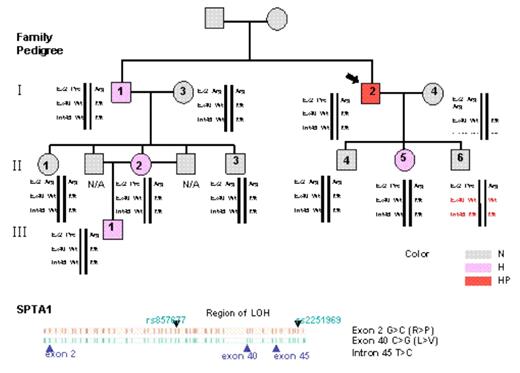Abstract
Mutations of alpha spectrin involving the heterodimer self-association site represent a common group of membrane skeletal defects resulting in hereditary elliptocytosis (HE) and a closely related disorder, hereditary pyropoikilocytosis (HPP). HPP is characterized by extreme anisocytic microcytosis, hemolytic anemia, severe spectrin dimer self-association defect, and spectrin deficiency. The conventional explanation for the different phenotypes is that HPP subjects are compound heterozygotes for a functional alpha spectrin defect that interferes with tetramer assembly due to missense mutations (commonly present in exon 2), and a second defect that results in decreased synthesis of normal alpha spectrin. In contrast, HE subjects have normal spectrin content and a less severe self-association defect. The modifying factor accounting for decreased synthesis of alpha spectrin is a hypomorphic mutation termed alpha spectrin LELY. LELY is a low-expression allele of the alpha spectrin gene characterized by a C>G mutation in codon 1857 of exon 40 and a C>T mutation in intron 45 resulting in decreased assembly of alpha/beta spectrin dimers. Here, we describe a family of Northern European descent in which six members in three generations were heterozygous for a novel mutation in alpha spectrin exon 2, codon 34: CGG->CCG (Arg>Pro) and for alpha spectrin LELY inherited in trans. Affected members harboring this novel exon 2 mutation exhibit three different RBC phenotypes: atypical HPP (1/6), HE (4/6), and normal (1/6) (see figure). Quantitation of RBC membrane proteins in subjects with abnormal RBC morphology revealed an increase in spectrin dimers due to an increase in the mutant 74kD alpha spectrin peptide. There was a significant association of abnormal morphology with the levels of dimers and mutant 74kD peptide (N<HE<HPP). In addition, HPP and HE subjects had a greater expression of mutant exon 2 allele compared to wild type (by allele specific PCR) at a ratio approximating 3:1. Moreover, the HPP subject had a decreased amount of reticulocyte total alpha spectrin mRNA (~10% of normal) while HE individuals had only a slight decrease in reticulocyte total alpha spectrin mRNA (~ 85% of normal). One individual (II-6), who had an exon 2 missense mutation and homozygous intron 45 LELY mutation exhibiting normal RBC morphology, was investigated in greater detail. After ruling out non-paternity by standard testing, genotyping of his alpha spectrin gene was performed and an intragenic crossover detected, resulting in homozygosity for the intron 45 LELY mutation and wild type exon 40 (see figure). We conclude that the phenotype of individual II-6 is ameliorated by this de novo mitotic event. The HPP phenotype of the propositus is likely due to decreased transcription of both alpha spectrin alleles; however, its molecular basis remains to be determined. # Equal contribution.
Disclosures: No relevant conflicts of interest to declare.
Author notes
Corresponding author


This feature is available to Subscribers Only
Sign In or Create an Account Close Modal